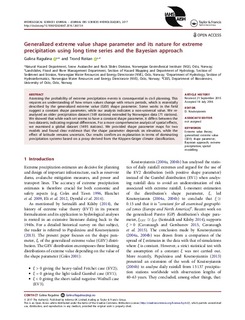| dc.contributor.author | Ragulina, Galina | |
| dc.contributor.author | Reitan, Trond | |
| dc.date.accessioned | 2017-06-23T11:05:49Z | |
| dc.date.available | 2017-06-23T11:05:49Z | |
| dc.date.created | 2017-01-20T07:33:40Z | |
| dc.date.issued | 2017 | |
| dc.identifier.issn | 0262-6667 | |
| dc.identifier.uri | http://hdl.handle.net/11250/2446795 | |
| dc.description.abstract | Assessing the probability of extreme precipitation events is consequential in civil planning. This requires an understanding of how return values change with return periods, which is essentially described by the generalized extreme value (GEV) shape parameter. Some works in the field suggest a constant shape parameter, while our analysis indicates a non-universal value. We re-analysed an older precipitation dataset (169 stations) extended by Norwegian data (71 stations). We showed that while each set seems to have a constant shape parameter, it differs between the two datasets, indicating regional differences. For a more comprehensive analysis of spatial effects, we examined a global dataset (1495 stations). We provided shape parameter maps for two models and found clear evidence that the shape parameter depends on elevation, while the effect of latitude remains uncertain. Our results confirm an explanation in terms of dominating precipitation systems based on a proxy derived from the Köppen-Geiger climate classification. | |
| dc.language.iso | eng | |
| dc.relation.uri | http://dx.doi.org/10.1080/02626667.2016.1260134 | |
| dc.title | Generalized extreme value shape parameter and its nature for extreme precipitation using long time series and the Bayesian approach | |
| dc.type | Peer reviewed | |
| dc.type | Journal article | |
| dc.source.journal | Hydrological Sciences Journal | |
| dc.identifier.doi | 10.1080/02626667.2016.1260134 | |
| dc.identifier.cristin | 1432958 | |
| cristin.unitcode | 7452,20,0,0 | |
| cristin.unitname | Naturskade | |
| cristin.ispublished | true | |
| cristin.fulltext | original | |
| cristin.qualitycode | 1 | |
